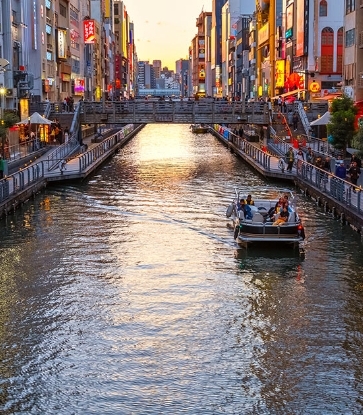Nara
Kasugataisha Shrine
The vivid vermillion-colored buildings of this large and ancient shrine contrast beautifully with the lush greenery of the forest in which it stands. The main shrine buildings are surrounded by long corridors lined with 1,000 hanging lanterns, which is a beautiful sight indeed, and the 2,000 stone lanterns are in the grounds. This shrine was built in the 8th century, when Nara was Japan’s capital, for the protection of the country’s prosperity and the happiness of its people.
Mt. Kasuga Primeval Forest
Untouched for thousands of years, Mt. Kasuga Primeval Forest stretches out across an area of around half a kilometer, behind Kasugataisha Shrine. With logging and hunting prohibited since AD 841, this is a rare ecosystem with over 175 types of trees, wild animals, rare birds and insects.
There are hiking courses in the forest that pass a waterfall and small caves carved with Buddha figures.

Nishinokyo
Yakushiji Temple
The Kondo or main hall is flanked by two gorgeous pagodas. The East Pagoda is the only surviving original 8th century structure. The main hall houses Yakushi Nyorai (Buddha of healing) seated on a stand decorated with motifs from the Silk Road: grape vines from Greece, Persian lotus flowers, figures from India and a dragon, phoenix, tiger and tortoise, the Chinese gods said to rule over the four directions.
Toshodaiji Temple
Passing through the restored wooden gates, you immediately see the elegant main hall with its large roof and muted colors. Beautifully proportioned eight pillars are allegedly inspired by the Parthenon of Greece. The temple was founded in 759 by Ganjin, a Chinese priest from the Tang Dynasty, invited to Japan by Emperor Shomu to train priests and further propagate Buddhism in the country. Follow the paths to a mossy forest to visit the grave of Ganjin. Here, you can savor the changing of four seasons such as bird songs, summer coolness, and autumn colors.

Horyuji Temple
Buddhist Monuments in the Horyuji Area
The first Japanese site to be inscribed onto the World Heritage List in 1993, there are 48 Buddhist sites around Horyuji Temple and Hokiji Temple. Many of the buildings date from the late 7th century, making them the oldest surviving wooden buildings in the world. The Horyuji area was also chosen for its contribution to Japanese culture and the history of religion in Japan.
The west side of Horyuji Temple holds the main hall and a five-story pagoda, one of the world’s oldest wooden buildings, enclosed by wooden cloisters. The bronze Shaka Triad showing Buddha and two bodhisattvas crafted in 623, is the key object in the main hall. Next to it is a five-story pagoda, with scenes from Buddhist story created in clay in 711. It is said that a fragment of Buddha’s bones is enshrined below the base of a five-story pagoda.

Yoshino
Sacred Sites and Pilgrimage Routes in the Ki Mountain Range
World Heritage pilgrimage routes run through the mountains of southern Nara Prefecture. This, the Yoshino and Omine area, includes Mt. Yoshino, famous for its cherry blossoms, and as a center of Shugendo, a fusion of Buddhism and Shinto nature worship dating back to the 12th century. For many, travelling these paths awakens a deep sense of reverence for nature. Pilgrims still walk these routes today. The only other World Heritage pilgrimage route is Spain’s Santiago e Compostela.

Learn More about Nara
Back to NARA, THE BIRTHPLACE OF JAPAN















